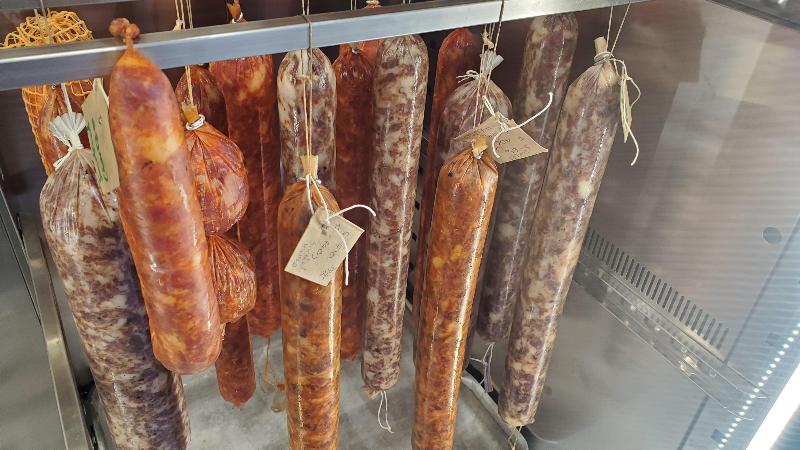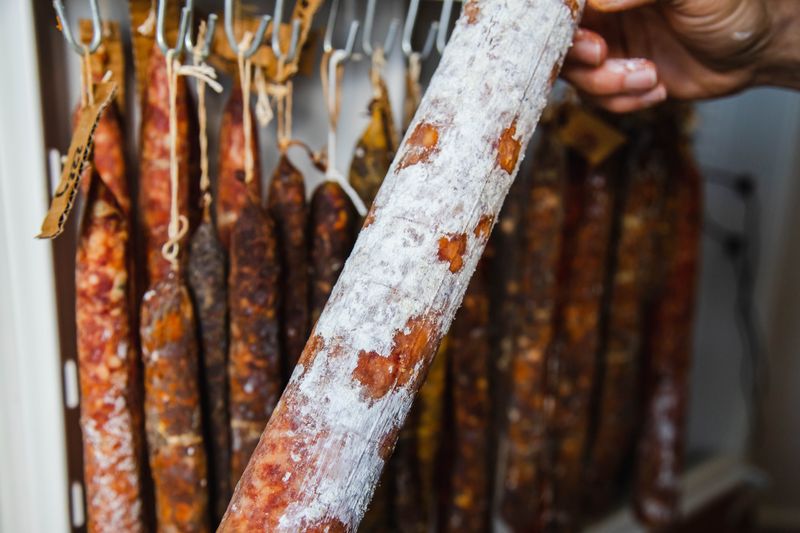Salami is always seen hanging; it’s not as apparent to someone who hasn’t made or learned about salami why this is.
After teaching, learning, and making salami for many years – here are the finer points in detail below. The primary reason, however, is this.
These factors are specific to traditional Artisanal dry-cured salami, which is often fermented as a first stage with a starter culture. Then, it dried for weeks, if not months.
Commercial large-volume salami in many parts of the world uses fast acidification to avoid the traditional process, which is often evident in its very moist texture (more like ham in some ways.
Dry-cured traditional salami is firm when touched or squeezed since it has lost at least 35% of its starting weight, often 45%.
When salami is hung for drying, less contact means less chance of contamination. Dry-cured salami is dried more effectively when hung. Moisture is more easily diffused, and evaporation occurs on the surface of the salami.
For hundreds of years, salami has been hung for many reasons; let’s elaborate on why it is essential for this craft and process.
Advantages of Hanging Salami in Detail
- Maximum Surface Exposure
- Less Chance of Contamination
- Gravity Assisted Drying
- Easier to Inspect
- Smoking Easier if Salami Hung
- Keeps Shape Uniform

Maximum Surface Exposure
Hanging salami allows more air circulation. Since moisture is being drawn to the surface of the salami casing, the space between each salami helps a lot during this process.
This airflow helps maintain consistent drying conditions and facilitates moisture removal from the salami’s surface, promoting uniform drying.
Ideally, airflow is slightly higher during the initial few weeks of drying salami, and then it can be reduced to approximately 50%.
Less Chance of Contamination
When dry-cured salami (here is an article on salami ideas you can make at home to try) is hung, less contact with any object will minimize the salami contamination.
Casing is one level of protection for the salami, as well as salt and acidity, and possibly if it’s been cold-smoked. This is part of the complexity of creation and flavor – since several proponents are involved in the salami creation.
Salamis next to each other should also be separated for this purpose.
Gravity Assisted Drying
Some salami I’ve created has had rapid moisture loss during the first few days, whether in the drying or fermentation stage.
The moisture will leak from the hanging salami. If the salami is hung, this can also assist in drying.
Easier to Inspect

Salami should often be inspected on the surface at all stages; many styles of salami will grow beneficial mold on the surface of the casing.
Vinegar and other acidic substances can be used to remove unwanted types of mold or overgrowth of beneficial mold. However, beneficial mold often assists in regulating moisture loss.
Smoking Easier if Salami Hung
If all parts of the salami casing are exposed to cold smoke, more smoke vapor will surround the salami.
I’ve had experiences of cold smoking (full article on cold smoking I wrote) on racks, which can noticeably show the smoke vapor not coming into contact with the salami.
Keep Shape Uniform
For round, even drying, hanging helps keep the salami’s shape during the weeks or months it takes to complete.
However, some salami (here is a link to the category on this site about salami) is pressed into an oval or rectangular shape. Most will be of the round style across the world.
I have written a comprehensive article here if you would like a beginner introduction to salami making.

Tom Mueller
For decades, immersed in studying, working, learning, and teaching the craft of meat curing, sharing the passion and showcasing the world of charcuterie and smoked meat. Read More
